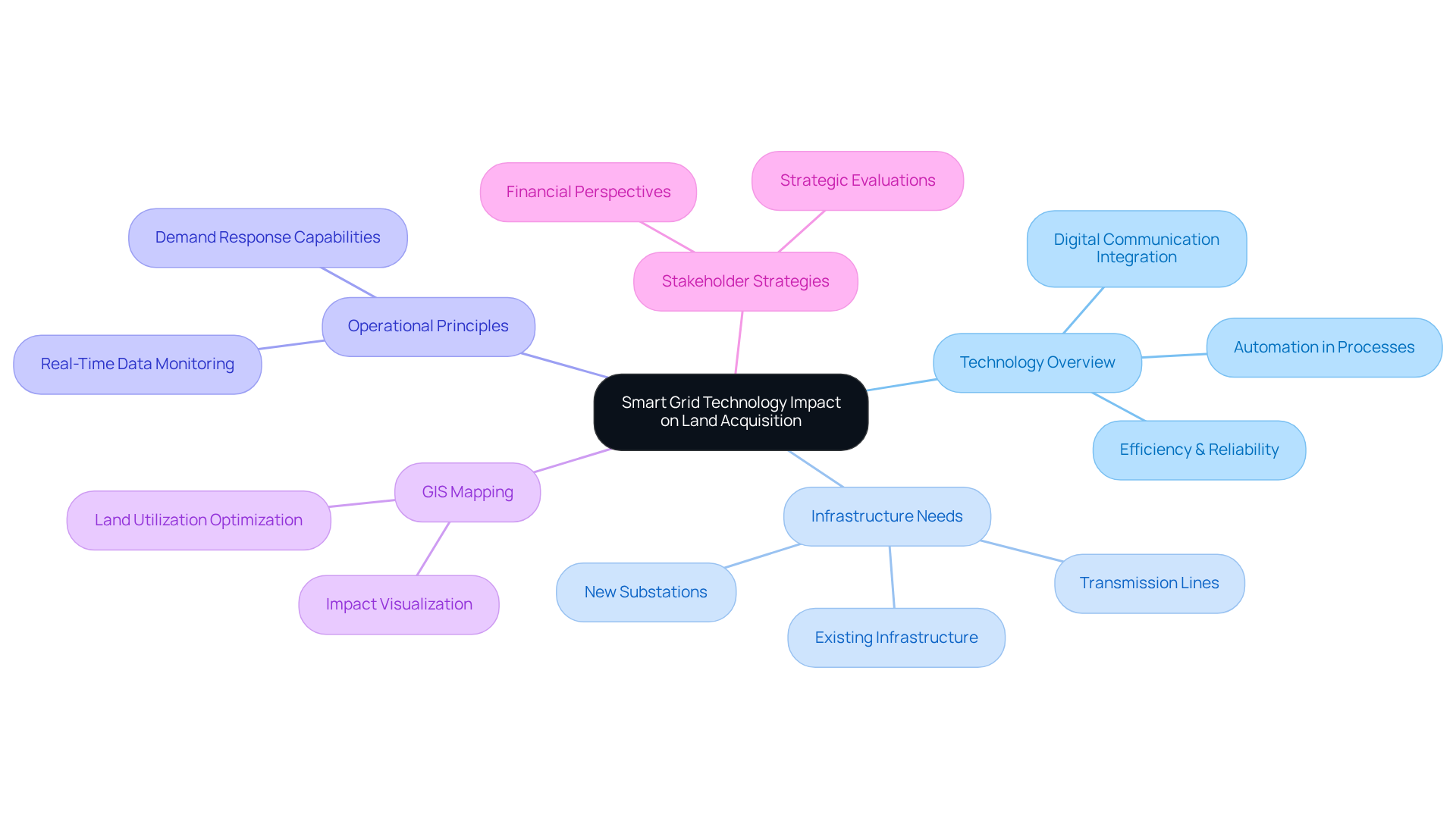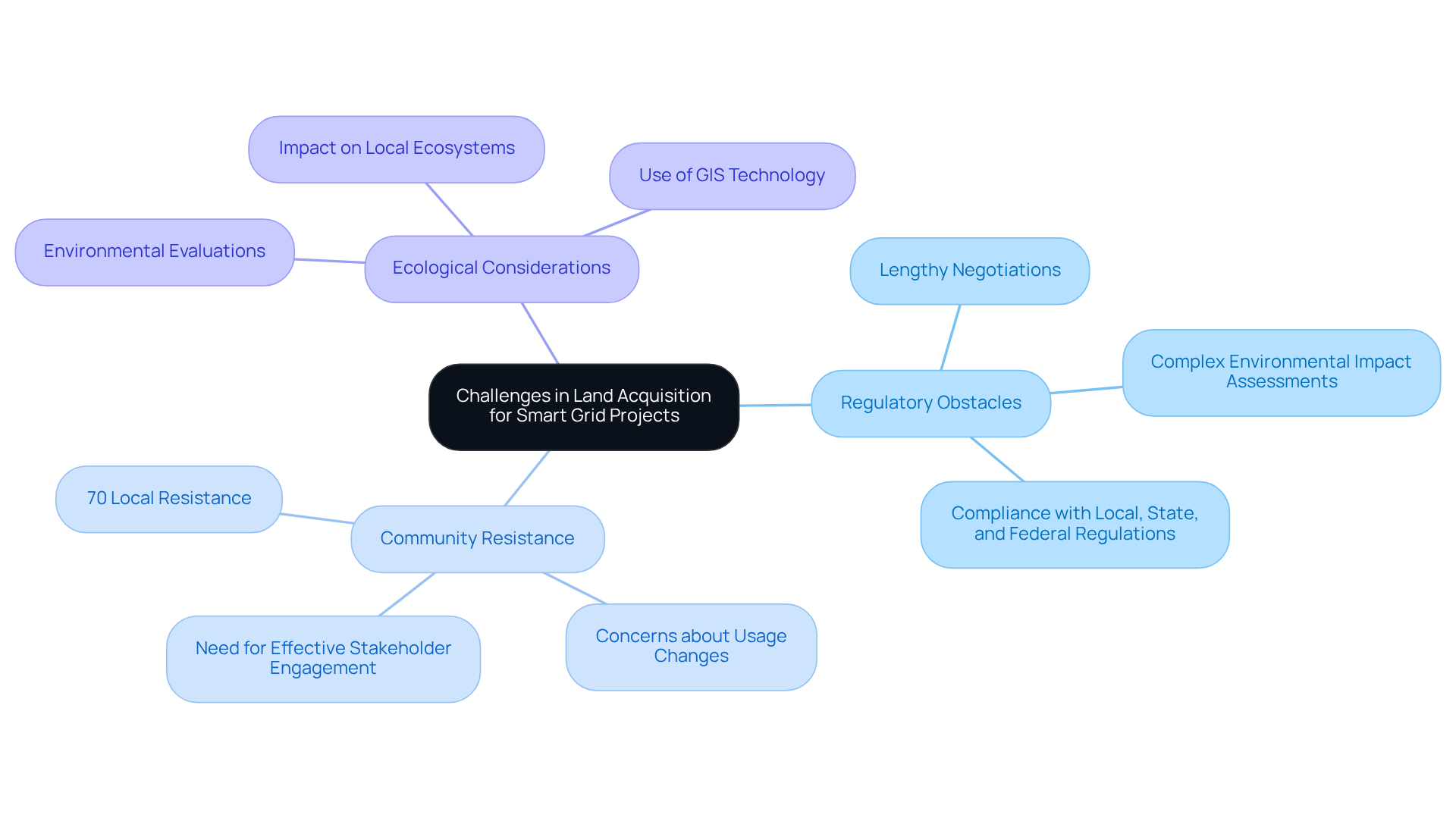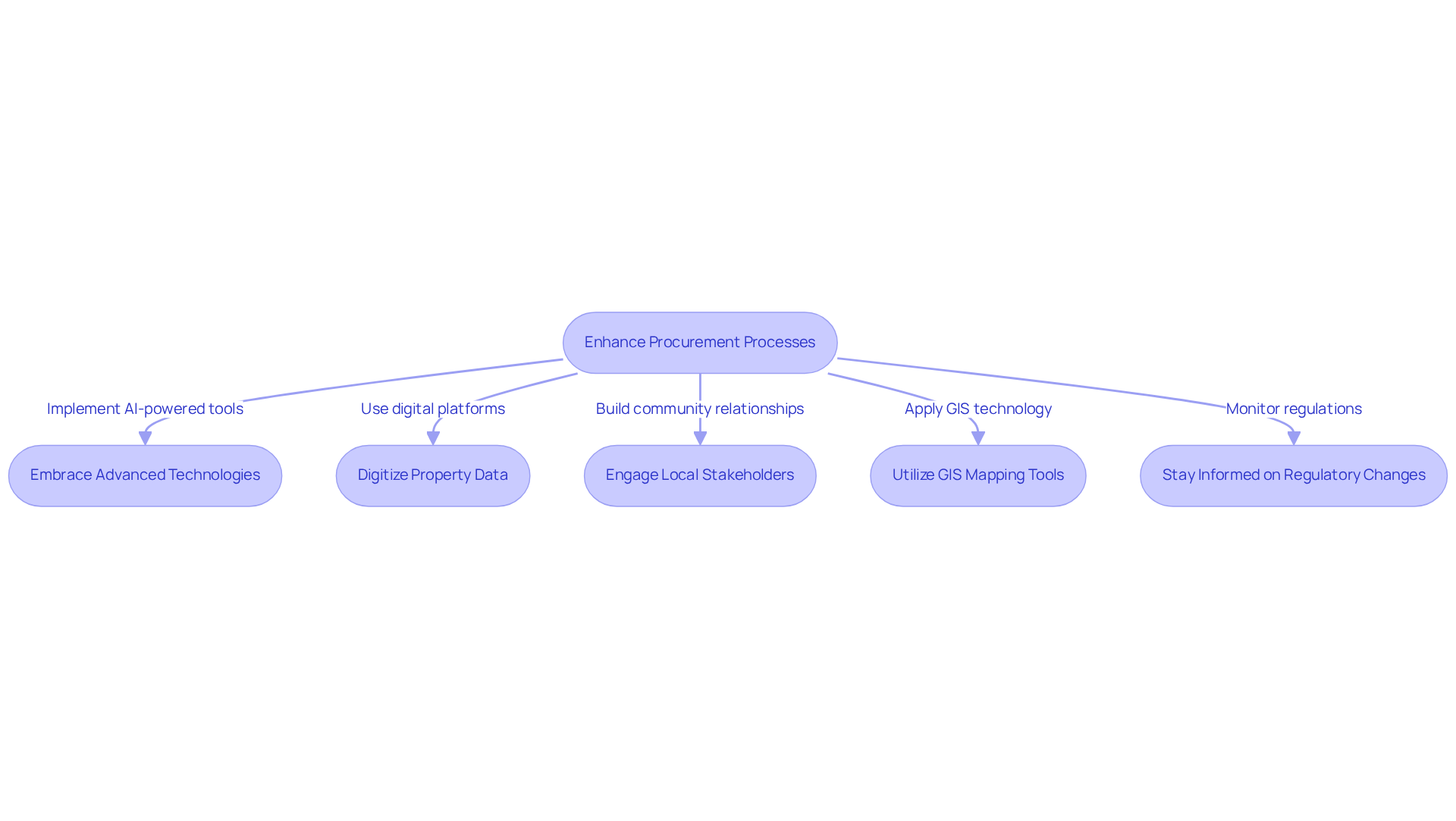Overview
The article addresses the pressing challenge of managing land acquisition in the context of smart grid-enabled transmission upgrades. It highlights three pivotal strategies:
- Leveraging advanced technologies such as GIS mapping and AI-powered tools
- Engaging actively with local communities
- Remaining vigilant about regulatory changes
By implementing these strategies, stakeholders can streamline the procurement process and significantly enhance project outcomes.
First, the use of advanced technologies is crucial. GIS mapping and AI tools not only provide accurate data but also facilitate informed decision-making, thereby reducing delays. How can your organization harness these technologies to overcome existing hurdles?
Next, engaging with local communities is essential. Building trust and understanding local concerns fosters a collaborative environment that can lead to smoother negotiations and approvals. Are you actively involving community voices in your planning processes?
Finally, staying informed about regulatory changes is vital. The landscape of land acquisition is continually evolving, and being proactive in understanding these changes can prevent costly setbacks. How prepared is your organization to adapt to new regulations?
In conclusion, by embracing these strategies, organizations can effectively navigate the complexities of land acquisition, ultimately leading to successful project execution and improved outcomes.
Introduction
The rapid evolution of smart grid technology is fundamentally reshaping the energy transmission landscape, heralding enhanced efficiency and reliability. As this transformation progresses, stakeholders confront the imperative of adapting their land acquisition strategies to meet new infrastructure demands. However, the complexities of regulatory hurdles, community resistance, and environmental considerations present significant challenges.
How can organizations effectively leverage advancements in smart grid technology to streamline their procurement processes while simultaneously fostering positive relationships with local communities?
Understand Smart Grid Technology and Its Impact on Land Acquisition
Smart technology is revolutionizing the electricity system by integrating digital communication and automation, which significantly enhances efficiency and reliability. This transformation necessitates a reevaluation of property procurement strategies. The execution of intelligent networks often requires new infrastructure, such as substations and transmission lines, which may conflict with current land use. Understanding the operational principles of intelligent grids—such as real-time data monitoring and demand response capabilities—is crucial for identifying suitable property parcels.
For instance, prioritizing areas with existing infrastructure can minimize disruption and reduce costs. Furthermore, the implementation of intelligent network technologies can elevate property values, prompting stakeholders to evaluate property procurement from both financial and strategic perspectives.
Employing GIS mapping tools can effectively illustrate potential impacts and optimize land utilization for intelligent energy projects. This ensures that land procurement aligns with the evolving energy landscape.
In conclusion, as the energy environment shifts, it is imperative for stakeholders to adapt their strategies to leverage the benefits of smart technology. By rethinking property acquisition through an informed lens, organizations can navigate the complexities of land procurement while enhancing project outcomes.

Identify Challenges in Land Acquisition for Smart Grid Projects
Land procurement for intelligent network initiatives presents significant challenges, including regulatory obstacles, community resistance, and ecological considerations. The regulatory landscape varies considerably across states, complicating the procurement process. For example, obtaining necessary permits often requires lengthy negotiations with local authorities, which can extend project timelines due to the complexities of environmental impact assessments and compliance with local, state, and federal regulations.
Community opposition is a critical issue, with data indicating that nearly 70% of smart grid initiatives face some form of local resistance, primarily stemming from concerns about usage changes and environmental impacts. This highlights the urgent need for effective stakeholder engagement strategies; proactive communication with local communities can substantially reduce resistance.
Moreover, environmental evaluations are essential for ensuring compliance with federal and state regulations, further complicating the procurement process. To effectively navigate these challenges, it is vital to conduct thorough due diligence, engage local communities early in the planning stages, and leverage technological advancements such as Geographic Information Systems (GIS) to identify and address potential usage conflicts. By adopting these strategies, organizations can streamline their procurement efforts and foster positive relationships with stakeholders.

Implement Strategies for Smart Grid-Enabled Land Acquisition
To enhance procurement processes, stakeholders must embrace a multi-faceted approach to smart grid-enabled transmission upgrades. Advanced technologies, such as AI-powered title research software, significantly boost efficiency in determining property ownership and resolving title issues. This software swiftly analyzes vast datasets, minimizing the time spent on manual searches and enhancing accuracy in title verification.
Moreover, Harbinger Land digitizes property data, enabling title agents to conduct title research and leasing with greater effectiveness. Establishing robust relationships with local stakeholders and executing effective community outreach can alleviate opposition and cultivate support for projects. Engaging with community leaders and addressing concerns transparently fosters smoother negotiations and higher acceptance rates.
For example, a case study involving a solar developer illustrated that early engagement with local communities, coupled with GIS mapping tools from Harbinger Land, reduced acquisition timelines by 30%. These tools optimize site selection by visualizing land use patterns and identifying potential conflicts early in the process.
Lastly, remaining informed about regulatory changes and adapting strategies accordingly is vital for maintaining compliance and avoiding delays. This proactive approach ensures that projects progress smoothly and efficiently.

Conclusion
The integration of smart grid technology into energy transmission is not merely a trend; it signifies a fundamental shift that demands a reevaluation of land acquisition strategies. As organizations adapt to the requirements of new infrastructure, comprehending the implications of smart technology becomes essential. This transition compels stakeholders to consider not only the efficiency and reliability benefits but also to navigate the complexities that arise in the procurement process.
Key challenges such as:
- Regulatory hurdles
- Community resistance
- Environmental considerations
have been identified as critical issues. Effective stakeholder engagement, leveraging advanced technologies like AI and GIS tools, and maintaining awareness of regulatory changes are vital strategies for overcoming these obstacles. By implementing these best practices, organizations can optimize their land acquisition processes, ultimately leading to more successful project outcomes.
In light of the evolving energy landscape, it is imperative for stakeholders to adopt these strategies and cultivate positive relationships with local communities. As smart grid technology advances, proactive engagement and informed decision-making will be crucial in ensuring that infrastructure projects not only comply with regulatory requirements but also secure community support. The future of energy transmission hinges on the ability to adapt and innovate in land acquisition practices, paving the way for sustainable and efficient energy solutions.
Frequently Asked Questions
What is smart grid technology?
Smart grid technology refers to the integration of digital communication and automation into the electricity system, which enhances efficiency and reliability.
How does smart grid technology impact land acquisition?
The implementation of smart grid technology often requires new infrastructure, such as substations and transmission lines, which may conflict with existing land use and necessitates a reevaluation of property procurement strategies.
Why is it important to understand the operational principles of intelligent grids?
Understanding the operational principles, such as real-time data monitoring and demand response capabilities, is crucial for identifying suitable property parcels for smart grid infrastructure.
What strategies can minimize disruption during land procurement for smart grid projects?
Prioritizing areas with existing infrastructure can minimize disruption and reduce costs during land procurement for smart grid projects.
How can intelligent network technologies affect property values?
The implementation of intelligent network technologies can elevate property values, prompting stakeholders to evaluate property procurement from both financial and strategic perspectives.
What tools can be used to optimize land utilization for intelligent energy projects?
GIS mapping tools can effectively illustrate potential impacts and optimize land utilization for intelligent energy projects.
Why is it important for stakeholders to adapt their strategies in land acquisition?
As the energy environment shifts, it is imperative for stakeholders to adapt their strategies to leverage the benefits of smart technology and navigate the complexities of land procurement while enhancing project outcomes.
List of Sources
- Understand Smart Grid Technology and Its Impact on Land Acquisition
- Leveraging Technology For Efficient Land Acquisition Processes - FasterCapital (https://fastercapital.com/topics/leveraging-technology-for-efficient-land-acquisition-processes.html/1)
- Identify Challenges in Land Acquisition for Smart Grid Projects
- Keys for Successful Land Acquisition for Energy Projects | Vanguard Real Estate Solutions (https://vresolutions.com/blog/successful-land-acquisition-for-energy-projects)
- Implement Strategies for Smart Grid-Enabled Land Acquisition
- 10 Real Estate AI Use Cases Transforming the Industry in 2025 (https://softkraft.co/real-estate-ai)
- AI in Real Estate: 30+ Statistics 2025 (https://artsmart.ai/blog/ai-in-real-estate-statistics)
- What Statistics Indicate Community Involvement's Impact on Project Success? → Question (https://sustainability-directory.com/question/what-statistics-indicate-community-involvements-impact-on-project-success)
- What Statistics Indicate the Impact of Community Participation on Energy Project Success? → Question (https://sustainability-directory.com/question/what-statistics-indicate-the-impact-of-community-participation-on-energy-project-success)
- Maximize Efficiency in Your Title Business with AI (https://skylinetitlesupport.com/blog/maximize-efficiency-in-your-title-business-with-ai)




